You have a Hallux Phalanx Fracture. This is a break to your big toe.
Healing
It normally takes 6-8 weeks for this to heal.
Smoking will slow down your healing. We would advise that you stop smoking while your fracture heals. Talk to your GP or got to www.smokefree.nhs.uk for more information.
Pain and swelling
You may have foot pain and swelling for 3-6 months after your injury. Swelling is often worse at the end of the day.
Taking pain medication, elevating your foot and using ice or cold packs will help. More information is on the next page.
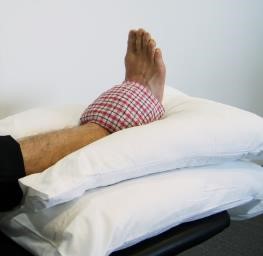
Walking, your boot and strapping
The boot (if provided) protects your foot and will make you more comfortable. Wear the boot when you are standing and walking. You can take it off at night and at rest. You need to wear the boot for 2-4 weeks after your injury. Your clinician may not have thought a boot was appropriate; in this case, please wear thick soled, supportive shoes (trainers are ideal) when you are standing and walking.
You are allowed to put weight through your foot. You may find it easier to use crutches in the early stages.
You should continue to buddy strap your toe for 4-6 weeks (strapping tape is available from your local pharmacy or supermarket). Once out of your boot, you should continue with a stiff soled shoe/trainer for 4-6 weeks after your injury.
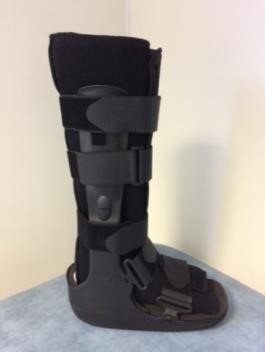
Exercises
It is important to start exercises as soon as possible. Instructions are below.
Follow up
A follow up appointment is not normally needed for this injury. If you still have significant pain and swelling after 8 weeks, then please contact your GP or NHS 111.
Any questions
If you are concerned about your symptoms, are unable to follow this rehabilitation plan or have pain other than at the site of your injury please contact the Emergency Department, your GP or NHS 111.
Caring for your injury: Weeks 1-2
Using a cold pack will help with your pain and swelling. You can use an ice pack or bag of frozen peas wrapped in a damp towel. Put this on your foot for up to 15 minutes every few hours. Make sure the ice is not in direct contact with your skin.
Try to rest your foot, especially in the first 24-72 hours. Raise your foot on a stool or cushions so that it is above the level of your hip. This will help to reduce your swelling.
Strapping
Padding should be place between the two toes to prevent rubbing and any breakdown of the skin. Ideally, the padding should extend almost the full length of the neighbouring toe.
Place one piece of tape around both toes, on the big toe between the foot and first joint and another between the first and second joint. If your toes start changing colour, or you get pins and needles sensation that wasn’t there before, then the strapping is too tight. Change the strapping daily to allow skin care.
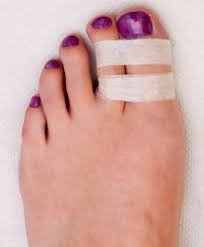
Exercises
Early movement of the ankle and foot is important to promote circulation and reduce the risk of developing a Deep Vein Thrombosis (blood clot). Do these exercises 3-4 times a day. Start straight away, you do not ned to push into pain.
- Point your foot up and down. Repeat this 10 times.
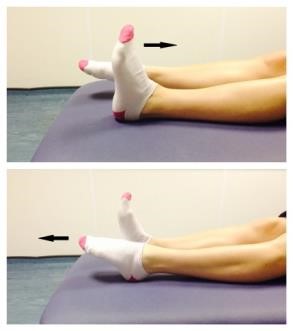
- With your heels together, move your toes apart to turn the foot outwards. Repeat this 10 times. Do this movement gently within comfort.
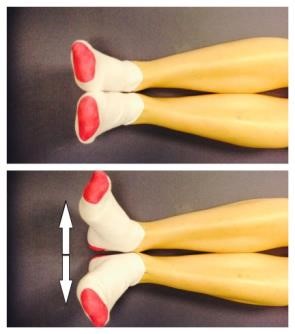
- Make gentle circles with your foot in one direction and then the other direction. Repeat this 10 times.
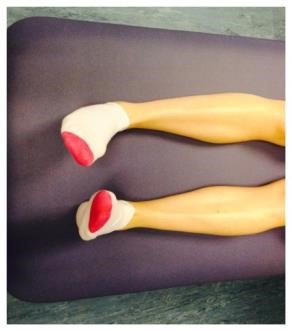
Caring for your injury: Weeks 2-6
It is now 2 weeks since your injury and you can start to wean out of your boot over the next few weeks.
Once out of the boot, you should wear a stiff soled shoe/trainer for up to 6 weeks from your injury. From week 4 you can start to wean off the use of the buddy strapping over the next few weeks. It is normal to still have mild discomfort and swelling. This may continue for 3-6 months.
Activity and exercise
Keep doing your exercises until you have full movement of your foot.
Gradually increase your level of activity. You should avoid impact activity for 3 months. This includes running and jumping.
Frequently asked questions
I am struggling with my boot. What do I do?
The boot has a thicker sole; this can make you feel uneven. Make sure you wear a supportive shoe or trainer on your uninjured foot. This will reduce stress on other joints.
I am diabetic, does this change things?
If you are diabetic, please ensure you check your skin regularly for any wounds or skin breakdown.
When can I start driving?
You can return to driving when:
- You are no longer using your boot
- You can walk comfortably
- You can perform an emergency stop pain free
Always test your ability to drive in a safe environment first.
How can I get a certificate for work?
You can self-certify for the first 7 days following your injury. For any longer periods, please contact your GP.
